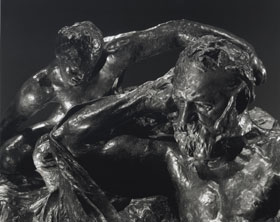Originally commissioned for the Panthéon in Paris, Rodin’s Monument to Victor Hugo was of great personal significance to the artist because, like his contemporaries, he idolized Hugo for his literary and political achievements. Although a plaster of the Monument was exhibited at the Paris Salon of 1897, it was not cast in bronze during Rodin’s lifetime.
The cast of the Monument in this exhibition, commissioned by the Iris & B. Gerald Cantor Foundation, was only the second one made and the first to be shown in the United States. The exhibition included Rodin’s studies for other versions of the Monument, as well as related figures and portrait studies that led to the final design. The exhibitition, consisting of four works on paper and twenty pieces of sculpture, included works in marble, bronze, plaster, and terra cotta. The Musée Rodin, Brooklyn Museum of Art, Fine Art Museums of San Francisco, Los Angeles County Museum of Art, Iris and B. Gerald Cantor Center for Visual Arts at Stanford University, Rodin Museum at the Philadelphia Museum of Art, and College of the Holy Cross all loaned pieces to the exhibition.

This exhibition visited five museums:
Los Angeles County Museum of Art
Los Angeles, California
December 17, 1998 – March 15, 1999 |
Portland Art Museum
Portland, Oregon
April 13, 1999 – June 11, 1999 |
Cummer Museum of Art and Gardens
Jacksonville, Florida
July 7, 1999 – September 19, 1999 |
The Metropolitan Museum of Art
New York, New York
October 6, 1999 – January 2, 2000 |
Iris and B. Gerald Cantor Center for Visual Arts
Stanford University
Stanford, California
January 26, 2000 – March 26, 2000 |
|
“I being of a modest income can not afford to see Rodin’s work in Paris but I have often dreamt about being close enough to it to study and lose myself in his work. Let me say that I have not been moved by art so much as I was moved the day I attended the…[exhibition]. While walking through the room my heart raced and I was breathless over and over again. I cannot say thank you enough.”